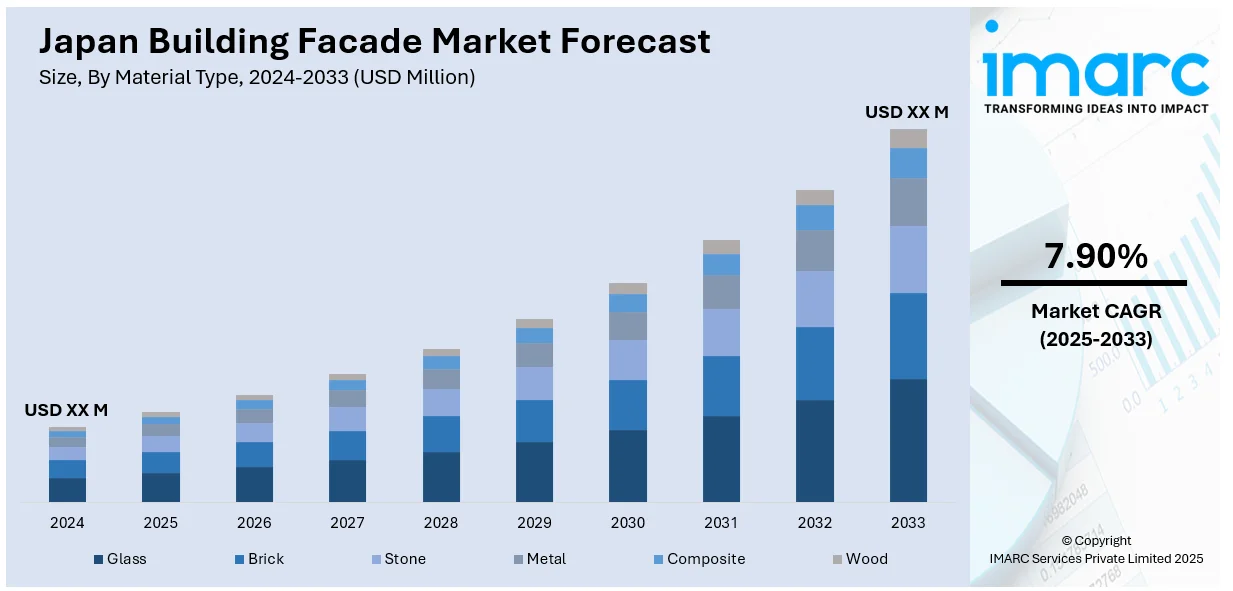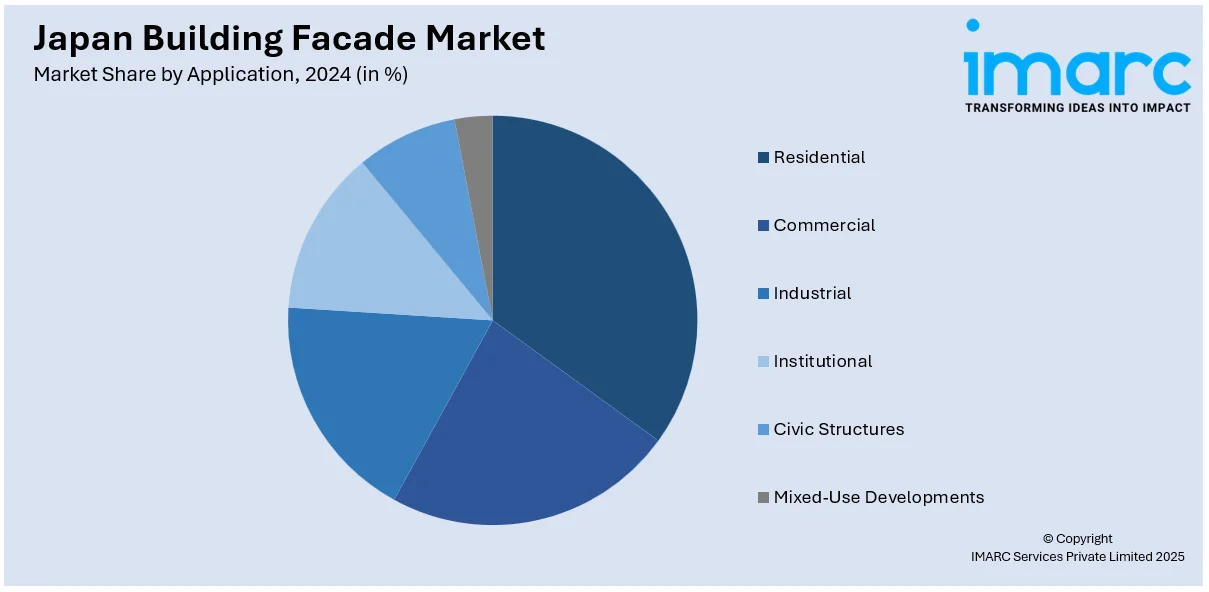
Japan Building Facade Market Size, Share, Trends and Forecast by Material Type, Product Type, Application, End User, and Region, 2025-2033
Japan Building Facade Market Overview:
The Japan building facade market size is projected to exhibit a growth rate (CAGR) of 7.90% during 2025-2033. The market is driven by stringent environmental regulations and Japan’s carbon neutrality goals, spurring demand for energy-efficient facades with high-performance glass and photovoltaic panels. Urbanization and mixed-use developments are fueling the adoption of customizable, aesthetic designs, leveraging materials such as aluminum composites and parametric 3D printing for brand differentiation. Government incentives, such as the Green Building Program, and smart facade innovations further amplify adoption, further augmenting the Japan building facade market share.
|
Report Attribute
|
Key Statistics
|
|---|---|
|
Base Year
|
2024
|
|
Forecast Years
|
2025-2033
|
|
Historical Years
|
2019-2024
|
| Market Growth Rate 2025-2033 | 7.90% |
Japan Building Facade Market Trends:
Increasing Adoption of Sustainable and Energy-Efficient Facade Solutions
The interest in sustainable and energy-efficient facade systems is on the increase in the market as a result of strict environmental policies and business society objectives. Japan's drive to reach carbon neutrality by 2050 positions developers and architects in a quest towards greener materials, including high-performance glass, photovoltaic panels, and thermally insulated cladding, at the forefront. As a solution to achieve energy efficiency in buildings or to lower operational costs, these solutions perform better in reducing heat gain while optimizing natural light. As per a 2024 study, between 2005 and 2020, Japan witnessed a drop of over 50% in carbon emissions from demolition and construction activities, mostly due to a shift towards a stock-based society and enhanced efficiency in the use of building materials. The use of eco-friendly materials, particularly in building facades, is vital as Japan's population is shrinking, with core city areas such as Tokyo and Osaka having a high percentage of emissions. Adoption of such sustainable measures is crucial for achieving carbon neutrality by 2050. Additionally, green facades and living walls are gaining popularity in urban areas, contributing to improved air quality and urban biodiversity. The government’s Green Building Program further incentivizes the use of sustainable facade technologies through subsidies and tax benefits. As a result, manufacturers are innovating with smart facades that integrate IoT-enabled sensors for real-time energy monitoring, aligning with Japan’s smart city initiatives. This trend is expected to accelerate as businesses and homeowners increasingly prioritize long-term environmental and economic benefits.

Rising Popularity of Aesthetic and Customizable Facade Designs
The increasing preference for visually striking and customizable facade designs that reflect modern architectural aesthetics is propelling the Japan building facade market growth. With urbanization and the rise of mixed-use developments, building owners are investing in facades that enhance curb appeal and brand identity. Factories are working towards creating vaunted exterior facades through slender or futurist materials, including lightweight aluminium composites, precast concrete, and ultra-thin, thin ceramics. The parametric design and 3D printing forum are enabling extremely complex and customized patterns that were extremely challenging to attain conventionally. This trend is strongest in retail and commercial environments, where the distinctive, upscale facades are just as valuable marketing tools for attracting consumers and patrons. In addition, there will be ongoing emphasis on earthquake-resistant facade systems to ensure safety, but also the ability to design structures for their neighbors, or to have design freedom of their own. As Japan continues to adopt advanced methods of construction, demand for high-end bespoke facades will also grow, as this level of design activity gains traction through advances in digital design software and ongoing enhancements in the science of materials.
Japan Building Facade Market Segmentation:
IMARC Group provides an analysis of the key trends in each segment of the market, along with forecasts at the country and regional levels for 2025-2033. Our report has categorized the market based on material type, product type, application, and end user.
Material Type Insights:
- Glass
- Brick
- Stone
- Metal
- Composite
- Wood
The report has provided a detailed breakup and analysis of the market based on the material type. This includes glass, brick, stone, metal, composite, and wood.
Product Type Insights:
- Prefabricated Facades
- Modular Facades
- Cladding Systems
- Unitized Systems
- Rain Screen Systems
- Custom Designs
A detailed breakup and analysis of the market based on the product type have also been provided in the report. This includes prefabricated facades, modular facades, cladding systems, unitized systems, rain screen systems, and custom designs.
Application Insights:

- Residential
- Commercial
- Industrial
- Institutional
- Civic Structures
- Mixed-Use Developments
The report has provided a detailed breakup and analysis of the market based on the application. This includes residential, commercial, industrial, institutional, civic structures, and mixed-use developments.
End User Insights:
- Architects and Designers
- Construction Companies
- Real Estate Developers
- Building Owners and Managers
- Government and Regulatory Bodies
- Consultants and Engineers
A detailed breakup and analysis of the market based on the end user have also been provided in the report. This includes architects and designers, construction companies, real estate developers, building owners and managers, government and regulatory bodies, and consultants and engineers.
Regional Insights:
- Kanto Region
- Kansai/Kinki Region
- Central/ Chubu Region
- Kyushu-Okinawa Region
- Tohoku Region
- Chugoku Region
- Hokkaido Region
- Shikoku Region
The report has also provided a comprehensive analysis of all the major regional markets, which include Kanto Region, Kansai/Kinki Region, Central/ Chubu Region, Kyushu-Okinawa Region, Tohoku Region, Chugoku Region, Hokkaido Region, and Shikoku Region.
Competitive Landscape:
The market research report has also provided a comprehensive analysis of the competitive landscape. Competitive analysis such as market structure, key player positioning, top winning strategies, competitive dashboard, and company evaluation quadrant has been covered in the report. Also, detailed profiles of all major companies have been provided.
Japan Building Facade Market Report Coverage:
| Report Features | Details |
|---|---|
| Base Year of the Analysis | 2024 |
| Historical Period | 2019-2024 |
| Forecast Period | 2025-2033 |
| Units | Million USD |
| Scope of the Report |
Exploration of Historical Trends and Market Outlook, Industry Catalysts and Challenges, Segment-Wise Historical and Future Market Assessment:
|
| Material Types Covered | Glass, Brick, Stone, Metal, Composite, Wood |
| Product Types Covered | Prefabricated Facades, Modular Facades, Cladding Systems, Unitized Systems, Rain Screen Systems, Custom Designs |
| Applications Covered | Residential, Commercial, Industrial, Institutional, Civic Structures, Mixed-Use Developments |
| End Users Covered | Architects and Designers, Construction Companies, Real Estate Developers, Building Owners and Managers, Government and Regulatory Bodies, Consultants and Engineers |
| Regions Covered | Kanto Region, Kansai/Kinki Region, Central/ Chubu Region, Kyushu-Okinawa Region, Tohoku Region, Chugoku Region, Hokkaido Region, Shikoku Region |
| Customization Scope | 10% Free Customization |
| Post-Sale Analyst Support | 10-12 Weeks |
| Delivery Format | PDF and Excel through Email (We can also provide the editable version of the report in PPT/Word format on special request) |
Key Questions Answered in This Report:
- How has the Japan building facade market performed so far and how will it perform in the coming years?
- What is the breakup of the Japan building facade market on the basis of material type?
- What is the breakup of the Japan building facade market on the basis of product type?
- What is the breakup of the Japan building facade market on the basis of application?
- What is the breakup of the Japan building facade market on the basis of end user?
- What is the breakup of the Japan building facade market on the basis of region?
- What are the various stages in the value chain of the Japan building facade market?
- What are the key driving factors and challenges in the Japan building facade?
- What is the structure of the Japan building facade market and who are the key players?
- What is the degree of competition in the Japan building facade market?
Key Benefits for Stakeholders:
- IMARC’s industry report offers a comprehensive quantitative analysis of various market segments, historical and current market trends, market forecasts, and dynamics of the Japan building facade market from 2019-2033.
- The research report provides the latest information on the market drivers, challenges, and opportunities in the Japan building facade market.
- Porter's five forces analysis assist stakeholders in assessing the impact of new entrants, competitive rivalry, supplier power, buyer power, and the threat of substitution. It helps stakeholders to analyze the level of competition within the Japan building facade industry and its attractiveness.
- Competitive landscape allows stakeholders to understand their competitive environment and provides an insight into the current positions of key players in the market.
Need more help?
- Speak to our experienced analysts for insights on the current market scenarios.
- Include additional segments and countries to customize the report as per your requirement.
- Gain an unparalleled competitive advantage in your domain by understanding how to utilize the report and positively impacting your operations and revenue.
- For further assistance, please connect with our analysts.
 Request Customization
Request Customization
 Speak to an Analyst
Speak to an Analyst
 Request Brochure
Request Brochure
 Inquire Before Buying
Inquire Before Buying




.webp)




.webp)












